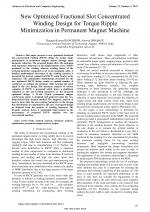| 4/2021 - 14 |
New Optimized Fractional Slot Concentrated Winding Design for Torque Ripple Minimization in Permanent Magnet MachineBANCHHOR, D. K. |
| Extra paper information in |
| Click to see author's profile in |
| Download PDF |
Author keywords
finite element analysis, harmonic analysis, optimization, permanent magnet motors, torque
References keywords
slot(21), fractional(18), windings(15), machines(13), ntrated(12), permanent(11), magnet(11), applications(10), winding(8), magnetics(8)
Blue keywords are present in both the references section and the paper title.
About this article
Date of Publication: 2021-11-30
Volume 21, Issue 4, Year 2021, On page(s): 127 - 134
ISSN: 1582-7445, e-ISSN: 1844-7600
Digital Object Identifier: 10.4316/AECE.2021.04014
Web of Science Accession Number: 000725107100014
SCOPUS ID: 85122229140
Abstract
This paper presents a new optimized fractional slot concentrated winding (FSCW) design for torque ripple minimization in permanent magnet motors through space harmonic reduction. The proposed design offers the minimum total harmonics distortion in the magnetomotive force (MMF) produced by the winding whereas winding factor of the working harmonic component is set to the maximum value. A detailed mathematical derivation of the winding function is presented for general symmetrical FSCW using Fourier series expansion. The optimization methodology presented for the new optimized FSCW design results in optimal number of conductors at optimal slot positions while keeping slot pitch equal in the core design. The harmonic analysis of various examples of FSCW is presented which shows a significant reduction in the non-working harmonics in the proposed optimized design. A 24-slot 22-pole permanent magnet synchronous motor is designed and analyzed using the two-dimensional finite element method. The magnetic analysis of motors shows that the non-working harmonics in the air-gap flux distribution are minimized in the case of proposed design as obtained from the analysis of winding functions. The dynamic analysis shows a substantial improvement in the performance of proposed FSCW machine over the conventional machine. |
| References | | | Cited By |
Web of Science® Times Cited: 1 [View]
View record in Web of Science® [View]
View Related Records® [View]
Updated 3 days, 14 hours ago
SCOPUS® Times Cited: 2
View record in SCOPUS® [Free preview]
View citations in SCOPUS® [Free preview]
[1] Dual Stator Electric Machine Equipped with Permanent Magnets on Both Stators, Chukwuemeka C. Awah,, Russian Electrical Engineering, ISSN 1068-3712, Issue 8, Volume 95, 2024.
Digital Object Identifier: 10.3103/S1068371224700846 [CrossRef]
[2] Six-phase Fractional Slot Concentrated Winding Permanent Magnet Synchronous Motor with Reduced Torque Ripple, Munteanu, Adrian, 2022 International Conference and Exposition on Electrical And Power Engineering (EPE), ISBN 978-1-6654-8994-2, 2022.
Digital Object Identifier: 10.1109/EPE56121.2022.9959854 [CrossRef]
Disclaimer: All information displayed above was retrieved by using remote connections to respective databases. For the best user experience, we update all data by using background processes, and use caches in order to reduce the load on the servers we retrieve the information from. As we have no control on the availability of the database servers and sometimes the Internet connectivity may be affected, we do not guarantee the information is correct or complete. For the most accurate data, please always consult the database sites directly. Some external links require authentication or an institutional subscription.
Web of Science® is a registered trademark of Clarivate Analytics, Scopus® is a registered trademark of Elsevier B.V., other product names, company names, brand names, trademarks and logos are the property of their respective owners.
Faculty of Electrical Engineering and Computer Science
Stefan cel Mare University of Suceava, Romania
All rights reserved: Advances in Electrical and Computer Engineering is a registered trademark of the Stefan cel Mare University of Suceava. No part of this publication may be reproduced, stored in a retrieval system, photocopied, recorded or archived, without the written permission from the Editor. When authors submit their papers for publication, they agree that the copyright for their article be transferred to the Faculty of Electrical Engineering and Computer Science, Stefan cel Mare University of Suceava, Romania, if and only if the articles are accepted for publication. The copyright covers the exclusive rights to reproduce and distribute the article, including reprints and translations.
Permission for other use: The copyright owner's consent does not extend to copying for general distribution, for promotion, for creating new works, or for resale. Specific written permission must be obtained from the Editor for such copying. Direct linking to files hosted on this website is strictly prohibited.
Disclaimer: Whilst every effort is made by the publishers and editorial board to see that no inaccurate or misleading data, opinions or statements appear in this journal, they wish to make it clear that all information and opinions formulated in the articles, as well as linguistic accuracy, are the sole responsibility of the author.



